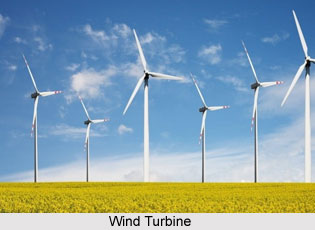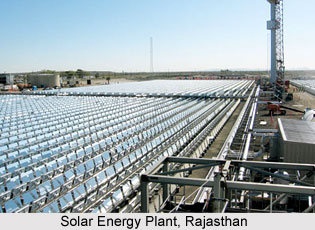Non-conventional sources of energy in India comprise those energy sources that are natural, inexhaustible as well as renewable. Like for instance, solar energy, tidal energy and wind energy. Interestingly, wind and running water were in use as sources of energy long before the conventional sources of energy like coal, mineral oil and natural gas came to be used widely. Initially, windmills were used for grinding grains as well as for pumping water. Wind and running water were also used for navigation. In present times, some of the major and extensively used non-conventional sources energy includes wind, tides, solar geo-thermal heat, biomass including farm and animal waste as well as human excreta. Like for instance, sewage from large cities can be used for generating biogas. All these sources are renewable or inexhaustible. They are inexpensive in nature. Some of the Non-Conventional Sources of Energy in India are as follows:
 Wind Energy
Wind Energy
This type of non-conventional energy can be used for pumping water, a prime need in irrigating farms in the countryside. Also, it can be used for generating electricity. The states of Gujarat, Tamil Nadu, Maharashtra and Orissa are better places in regard to this energy. Areas with constant and high speed winds are suitable for the purpose. Besides windmills, there are also wind farms.
Tidal Energy
This is another unlimited and inexhaustible source of energy. In order to generate electricity from tidal energy, barrages are constructed around estuaries to utilise incoming and outgoing tides and waves. The water is then utilised to force turbines to produce electricity by means of using the water. The tidal range should at least be of at least 7 m, for economical functioning. The Gulf of Kutch is preferably suited to build up electricity from the energy produced by high and lofty tides entering into slender creeks.
 Solar Energy
Solar Energy
The most copious and inexhaustible source of energy is the sun. It is a universal source and has huge potential and thus solar energy is one of the most prominent non-conventional energy used in the country. A notable achievement has been the solar cookers that are very cost effective. They help in cooking food almost without any-cost. Further, several small and medium size solar power stations are being planned for rural areas of the country. Some of the successful applications of the solar energy so far have been for cooking, water heating, water desalination, space heating, and crop drying. It is also predicted that it is going to be the energy of future when fossil fuels, namely coal and oil, would be totally exhausted.
Measures to Produce Non-Conventional Source of Energy
Thermal Energy
Geo-thermal energy is the use of natural heat, present on the surface and underneath the earth, particularly in the pores and cracks inside the earth`s crust. This energy source can be profitably made use of for numerous purposes. India is not rich in thermal energy source. However, efforts are on for the complete utilisation of natural energy of the hot springs at Manikaran in Himachal Pradesh. Energy so formed can be used for running cold storage plants.
Biomass
Biomass is a significant resource of power which accounts for around one third of the total fuel consumed in India. Biomass is widely used in households for the purpose of heating and cooking. Agricultural wastes, charcoal, wood, parched dung are used as bio-mass in rural areas. Several efforts are being made in the country for making proper use of biomass in an effective manner. The two main components of the biomass programme are production and utilisation of biomass.
Energy Plantation
Waste and bare lands are being used for plantation of fast growing shrubs and trees with high calorific value. They in turn give fuel wood, charcoal, fodder, power and most importantly scopes for rural employment. Through the gasification scheme, these energy plantations over around 8,000 hectares were annually producing nearly 1.5 mw power.
Energy from Urban Waste
A pilot plant for the purpose of demonstration has been set up in Delhi for treating solid municipal waste for conversion into energy. It produces huge amount of energy every year. Moreover, sewage in cities is used for producing gas and electricity.
Bagasse based Power Plants
It has been estimated that sugar mills in India can produce more than 2,000 mw extra electricity during crushing season. The energy produced by a mill would firstly meet its own power requirements and the rest can be utilised in irrigating fields by feeding it into the local grid. Like bagasse, several other farm wastes such as rice husk are also being used to produce electricity in India.
Farm, Animal and Human Wastes
By using farm and animal wastes as well as human excreta, `Gobar Gas` plants are being set up in several villages for making them self sufficient in their power necessities. The power so produced is used for cooking, lighting homes and streets and meeting irrigation needs of the village. The plants are being set up both at individual and community village levels.
Lastly, the biggest share of energy is used in the country in the kitchens. Wood and cow dung have been the universal sources of energy. Sadly, the traditional `chulhas` are wasteful means of cooking food. The improved varieties of efficient and smokeless chulhas help in saving firewood. These are some of the most popular and widely used non-conventional energy sources in the country.



















